The AMD Ryzen Threadripper 3960X and 3970X Review: 24 and 32 Cores on 7nm
by Dr. Ian Cutress, Andrei Frumusanu & Gavin Bonshor on November 25, 2019 9:05 AM ESTPower Consumption
One of our key conclusions from our Ryzen 9 3950X review is that AMD’s TDP number on the box was now somewhat a blurred line, with the processor instead taking the ‘Package Power Tracking’ or PPT value as its true peak power consumption. This meant that for a processor to have 105 W TDP on the box, the default PPT of 142 W meant that we saw power consumption around 142 W rather than 105 W. One concern going into this review is that AMD would take a similar line with the Zen 2-based Threadripper parts as well.
Both of the TR 3960X and TR 3970X processors have a list box TDP of 280 W, which is a new ‘record’ for high power consumption in a consumer CPU. In the enterprise space we see some specialist processors break the 400W mark, but those CPUs exist in environments with a variety of cooling methods and sound isn’t much of a concern. Conversely, these AMD processors will have to live in a box under someone’s desk, so there has to be a point where the TDP is too much. Last AMD generation was 250W, this one is 280W: if we’re not there already, then this should be a practical limit. AMD of course recommends liquid cooling with a good pump and a big radiator, so anyone buying one of these processors should look into spending at least another $120+ on a good liquid cooling system.
For our power consumption metrics, we performed our usual testing: using an affinity mask to limit the cores in use, implement a high-powered workload, and then measure the power readings 30 seconds in. We take the power readings from the processor itself, using the internal registers that are designed to regulate how much the processor does a form of turbo but also regulate temperatures and so forth. This method is broadly accurate, assuming the motherboard supports the external reporting of these values, but depending on the processor family it also gives us insights into how much power is being derived from the cores individually and the package as a whole.
Here’s what we get for the 24-core 3960X:
When a single core is active, it consumes ~13.5 watts. This slowly goes down when more cores get loaded, but at 6 cores loaded we are still consuming ~12 watts per core. Even at 16 cores loaded, we’re still around 10 watts per core. This is pretty impressive. At full core loading, we’re fluctuating between 6 and 11 watts per core, as workloads get moved around to manage core loading.
From the peak power perspective, we hit 280 W with 22 cores loaded. It drops off a bit after that, like we saw with the Ryzen 9 3950X, but not by much at this time. It should be noted that as we reach these higher values, out of those 280 W, around 205 W is being used by the cores, while 75 W or so is for everything else: that means memory controllers, PCIe root complexes, and the infinity fabric. This 75 W value doesn’t vary that much, starting at 68 W even at single core load. This indicates that either IF doesn’t take much power as more cores are used, or it is on all the time.
Moving to the 3970X, and we see a similar picture:
With more cores, the power is spread around a lot more. One core loaded tops out at 13 watts, and at 11 cores loaded we can still manage above 10 watts per core. When fully loaded, we move down to as low as 3 W per core, but it does average out to around 6 watts per core. Checking the frequency at this loading and despite the 3.7 GHz base frequency, we actually have all the cores at 4.0 GHz. 32 cores at 4.0 GHz? Yes please.
The peak power metrics rise to just over 280 W when we hit 23 cores loaded and stay there, with no dip after hitting the peak. It would seem that the 3970X appears better built in that regard.
If we comment on the power between the cores and everything else, we again get a 205-210 W value for the power in the cores. This leaves 75 W or so for the rest of the chip, almost identical to the 3960X, and again this doesn’t waver much from 1 core loaded to all-cores loaded.
What will be interesting to see will be when we get the 3990X in to test as comparison. I expect that 75W value to go up – even if it goes to 100W, that leaves 180W for 64 cores, or around 3 W per core. Based on my estimates, we could be looking at anywhere from 3.0-3.5 GHz per core, which actually fits in nicely with the frequencies of the EPYC 7H12 which is also a 64-core 280W part, but for the high performance compute market.
When comparing peak power consumption to all the other CPUs in our review, as expected our new CPUs are near the top of the charts.
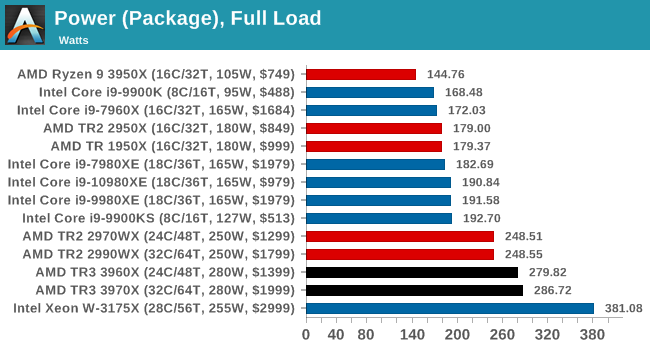
Only the unlocked 28-core from Intel peaks at a higher power, but funnily enough, that should only have a 255W TDP. So for four more cores, AMD’s peak power is still 100W below Intel’s. That’s the ‘power’ of the 7nm process node and some good quality chiplets.


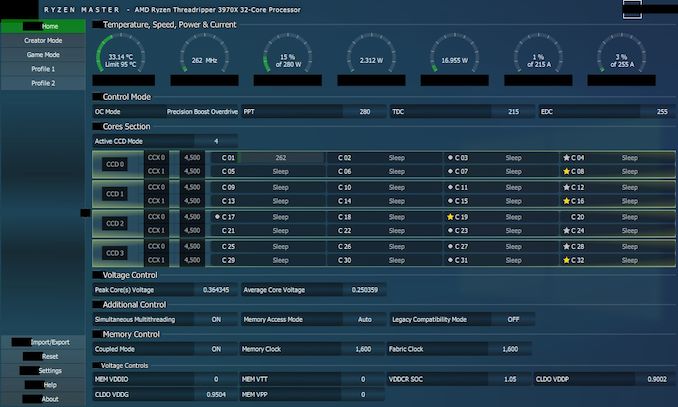
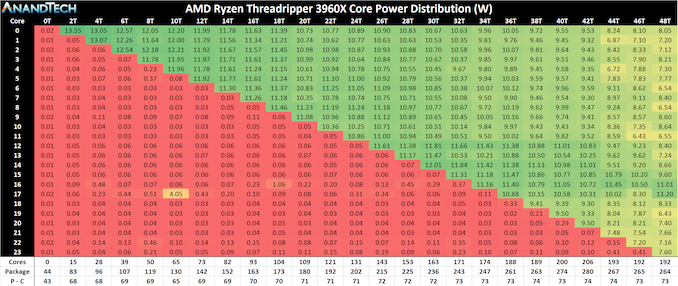
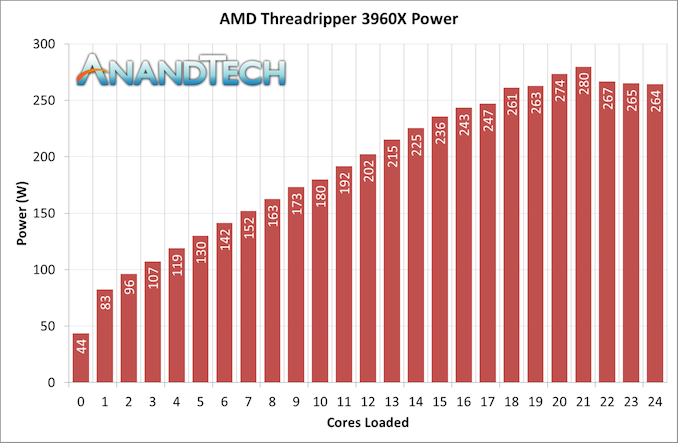
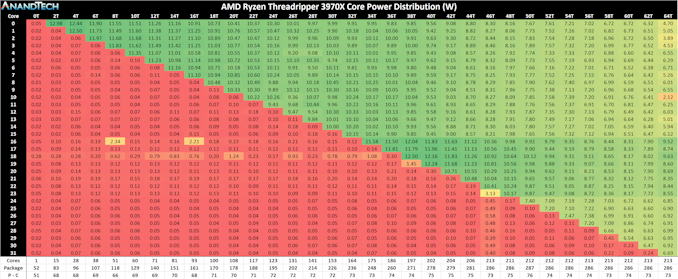
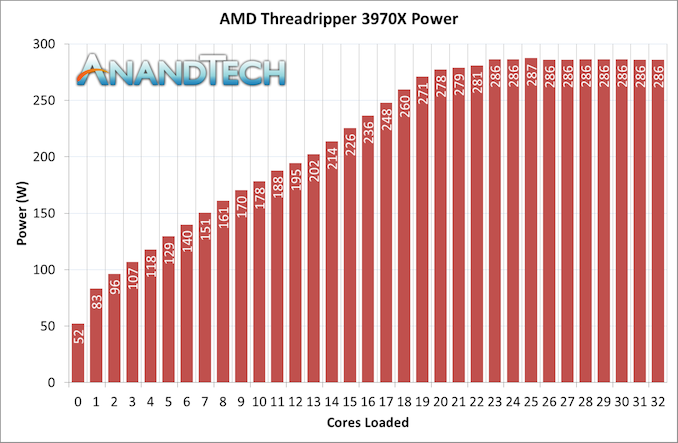








245 Comments
View All Comments
mazz7 - Monday, November 25, 2019 - link
I really thought that Anandtech viewers are smarter than others, but then i see the comments, I am really wrong about that ;pmartixy - Monday, November 25, 2019 - link
The amount of happy this makes me...Also, I'm glad to see y-cruncher in the test suite. It's been my goto power virus/perf benchmark since around the 0.5 versions.
boltcranck - Tuesday, November 26, 2019 - link
World of Tanks enCore is outdated, you should benchmark with the WoT enCoreRTwolfesteinabhi - Tuesday, November 26, 2019 - link
there us a cositant typo at several places .... 3960X is typed as 3950XTorrijos - Tuesday, November 26, 2019 - link
It would be interesting to present all the benchmarks in 2 graphs... The raw results, and then Bench/$.In order to have an idea of the financial benefits.
CraigIsSatoshiBsvIsBitcoin - Tuesday, November 26, 2019 - link
Looking forward to picking up a 64 core CPU for $200 in a couple of years..peevee - Tuesday, November 26, 2019 - link
Don't hold you breath. Well, maybe 64 in-order RISC cores. Not the same at all.liquid_c - Tuesday, November 26, 2019 - link
Gotta love how many people praise AMD and sh*t on Intel for this but just as many seem to forget that when AMD was in Intel’s place, they overcharged *way* more than Intel did / does. As a matter of fact, the 32c/64t gen3 TR costs 200$ more than last gen’s similar offering. The second AMD felt they caught a gust of wind, they slowly started inflating prices.I’m all for competition and i would love it if both Intel and AMD had some sort of control over final pricing (in my country, the 3900x costs ~700$...) but i have this distinct feeling that if things continue at this pace, AMD will become Intel 2.0, pricing and milking wise.
Bottom line - neither of the two are truly consumer friendly but memories fade and time tells its story at a slow pace.
M O B - Tuesday, November 26, 2019 - link
AMD isn't in Intel's place, and the last time there were (2003), they didn't overcharge.As for selling a 32-core CPU for $2000 on a brand new process node that also offers ECC, PCIe 4.0, and is 100W under the closest competitor--that isn't a position Intel has been in before. Even in 2012 Intel wasn't destroying the competition so utterly in single-core, multi-core, node, and feature-set at virtually ever price point.
What Intel will sell you is a 3 year old process node for $2000 like they did for the last 2 years. Rest assured that if Intel was in AMD's shoes right now that 32-core would be $3,000 and not have ECC support.
Plus, AMD has a $750 16-core that is plenty for the enthusiast market. This is truly a workstations CPU.
Xyler94 - Tuesday, November 26, 2019 - link
And Intel gets a pass on the 28 core overclocked Xeon that is priced at almost 4K?Listen, everyone wants to pay nothing for their products. But this chip isn't exactly cheap, and AMD is giving a heck of a deal on a processor Intel can't hope to make with their current processes. Remember that AMD's 64 core behemoth of a CPU only costs 7k, while Intel charges 10K for... 28 cores.